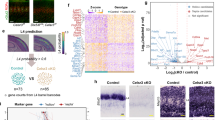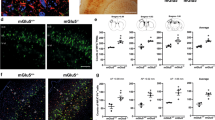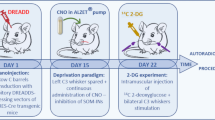Abstract
In the rodent primary somatosensory cortex, the configuration of whiskers and sinus hairs on the snout and of receptor-dense zones on the paws is topographically represented as discrete modules of layer IV granule cells (barrels) and thalamocortical afferent terminals1,2. The role of neural activity, particularly activity mediated by NMDARs (N-methyl-d-aspartate receptors), in patterning of the somatosensory cortex has been a subject of debate3,4,5,6. We have generated mice in which deletion of the NMDAR1 (NR1) gene is restricted to excitatory cortical neurons, and here we show that sensory periphery-related patterns develop normally in the brainstem and thalamic somatosensory relay stations of these mice. In the somatosensory cortex, thalamocortical afferents corresponding to large whiskers form patterns and display critical period plasticity, but their patterning is not as distinct as that seen in the cortex of normal mice. Other thalamocortical patterns corresponding to sinus hairs and digits are mostly absent. The cellular aggregates known as barrels and barrel boundaries do not develop even at sites where thalamocortical afferents cluster. Our findings indicate that cortical NMDARs are essential for the aggregation of layer IV cells into barrels and for development of the full complement of thalamocortical patterns.
This is a preview of subscription content, access via your institution
Access options
Subscribe to this journal
Receive 51 print issues and online access
$199.00 per year
only $3.90 per issue
Buy this article
- Purchase on Springer Link
- Instant access to full article PDF
Prices may be subject to local taxes which are calculated during checkout





Similar content being viewed by others
References
Woolsey, T. A. & Van der Loos, H. The structural organization of layer IV in the somatosensory region (SI) of the mouse cerebral cortex. Brain Res. 17, 205–242 (1970).
O'Leary, D. D. M., Ruff, N. L. & Dyck, R. H. Development, critical period plasticity, and adult reorganizations of mammalian somatosensory systems. Curr. Biol. 4, 535–544 (1994).
Chiaia, N. L., Fish, S. E., Bauer, W. R., Bennett-Clarke, C. A. & Rhoades, R. W. Postnatal blockade of cortical activity by tetrodotoxin does not disrupt the formation of vibrissa-related patterns in the rat's somatosensory cortex. Dev. Brain Res. 66, 244–250 (1992).
Schlaggar, B. L., Fox, K. & O'Leary, D. D. M. Postsynaptic control of plasticity in developing somatosensory cortex. Nature 364, 623– 626 (1993).
Fox, K., Schlaggar, B. L., Glazewski, S. & O'Leary, D. D. M. Glutamate receptor blockade at cortical synapses disrupts development of thalamocortical and columnar organization in somatosensory cortex. Proc. Natl Acad. Sci. USA 93, 5584–5589 ( 1996).
Iwasato, T. et al. NMDA receptor-dependent refinement of somatotopic maps. Neuron 19, 1201–1210 ( 1997).
Woolsey, T. A. in Development of Sensory Systems in Mammals, (ed. Coleman, E. J.) 461–516 (Wiley, New York, 1990).
Jhaveri, S. & Erzurumlu, R. S. in Development of the Central Nervous System in Vertebrates (eds Sharma, S. C. & Goffinet, A. M.) 167–178 (Plenum, New York, 1992).
Constantine-Paton, M., Cline, H. T. & Debski, E. Patterned activity, synaptic convergence, and the NMDA receptor in developing visual pathways. Annu. Rev. Neurosci. 13, 129–154 (1990).
Goodman, C. S. & Shatz, C. J. Developmental mechanisms that generate precise patterns of neuronal connectivity. Cell 72 (Suppl.), 77–98 (1993).
Cramer, K. S. & Sur, M. Activity-dependent remodeling of connections in the mammalian visual system. Curr. Opin. Neurobiol. 5, 106–111 (1995).
Li, Y., Erzurumlu, R. S., Chen, C., Jhaveri, S. & Tonegawa, S. Whisker-related neuronal patterns fail to develop in the trigeminal brainstem nuclei of NMDAR1 knockout mice. Cell 76, 427–437 (1994).
Kutsuwada, T. et al. Impairment of sucking response, trigeminal neuronal pattern formation, and hippocampal LTD in NMDA receptor ε2 subunit mutant mice. Neuron 16, 333–344 (1996).
Tsien, J. Z., Huerta, P. T. & Tonegawa, S. The essential role of hippocampal CA1 NMDA receptor-dependent synaptic plasticity in spatial memory. Cell 87, 1327–1338 (1996).
Gulisano, M., Broccoli, V., Pardini, C. & Boncinelli, E. Emx1 and Emx2 show different patterns of expression during proliferation and differentiation of the developing cerebral cortex in the mouse. Eur. J. Neurosci. 8, 1037–1050 (1996).
Yoshida, M. et al. Emx1 and Emx2 functions in development of dorsal telencephalon. Development 124, 101– 111 (1997).
Sakai, K. & Miyazaki, J.-I. A transgenic mouse line that retains Cre recombinase activity in mature oocytes irrespective of the cre transgene transmission. Biochem. Biophys. Res. Commun. 237, 318–324 (1997).
Erzurumlu, R. S. & Jhaveri, S. Thalamic axons confer a blueprint of the sensory periphery onto the developing rat somatosensory cortex. Dev. Brain Res. 56, 229– 234 (1990).
Ottersen, O. P. & Storm-Mathisen, J. Glutamate- and GABA-containing neurons in the mouse and rat brain, as demonstrated with a new immunocytochemical technique. J. Comp. Neurol. 229, 374–392 (1984).
Parnavelas, J. G. The origin and migration of cortical neurons: new vistas. Trends Neurosci. 23, 126–131 ( 2000).
Tanifuji, M., Yamanaka, A., Sunaba, R., Terakawa, S. & Toyama, K. Optical responses evoked by white matter stimulation in rat visual cortical slices and their relation to neural activities. Brain Res. 738, 83–95 ( 1996).
Feldmeyer, D., Egger, V., Lubke, J. & Sakmann, B. Reliable synaptic connections between pairs of excitatory layer 4 neurons within a single ‘barrel’ of developing rat somatosensory cortex. J. Physiol. (Lond.) 521, 169–190 (1999).
Wong-Riley, M. T. & Welt, C. Histochemical changes in cytochrome oxidase of cortical barrels after vibrissal removal in neonatal and adult mice. Proc. Natl Acad. Sci. USA 77, 2333–2337 (1980).
Cases, O. et al. Lack of barrels in the somatosensory cortex of monoamine oxidase A-deficient mice: Role of a serotonin excess during the critical period. Neuron 16, 297–307 ( 1996).
Jhaveri, S., Erzurumlu, R. S. & Crossin, K. Barrel construction in rodent neocortex: Role of thalamic afferents versus extracellular matrix molecules. Proc. Natl Acad. Sci. USA 88, 4489-4493 (1991).
Messersmith, E. K., Feller, M. B., Zhang, H. & Shatz, C. J. Migration of neocortical neurons in the absence of functional NMDA receptors. Mol. Cell Neurosci. 9, 347–357. (1997).
Harris, R. M. & Woolsey, T. A. Dendritic plasticity in mouse barrel cortex following postnatal vibrissa follicle damage. J. Comp. Neurol. 196, 357–376 (1981).
Katz, L. C. & Constantine-Paton, M. Relationship between segregated afferents and postsynaptic neurons in the optic tectum of three-eyed frogs. J. Neurosci. 8, 3160–3180 (1988).
Rajan, I. & Cline, H. T. Glutamate receptor activity is required for normal development of tectal cell dendrites in vivo. J. Neurosci. 18, 7836–7846 (1998).
Molnar, Z. & Hannan, A. J. in Mouse Brain Development (eds Goffinet, A. M. & Rakic, P.) 293–332 (Springer, Berlin, 2000).
Acknowledgements
We thank D. Gerber for critical reading; M. Yoshida and S. Aizawa for information and a probe of Emx1 gene; J. Tsien, Y. Li, J.-i. Miyazaki and A. Nagy for NR1flox/flox, NR1+/-, CAG-CAT-Z and CMV-Cre mice, respectively; C. Lovett for Cre/LacZ PCR primers; K. Crossin for tenascin antibody; M. Tanaka, H. Gomi, A. Kato, K. Ishii, T. Ikeda and H. Kanki for advice in experiments/manuscript preparation; T. A. Woolsey for helpful discussion; and N. Yoshida, Y. Onodera, R. Ando and R. Nomura for technical assistance. This work was supported by Grant-in-Aid for Scientific Research from the Ministry of Education, Science, Sports and Culture of Japan (T.I.), by the Whitehall Foundation and the NIH/NINDS (R.S.E.) and by the NIH (S.T.).
Author information
Authors and Affiliations
Corresponding author
Supplementary information
Rights and permissions
About this article
Cite this article
Iwasato, T., Datwani, A., Wolf, A. et al. Cortex-restricted disruption of NMDAR1 impairs neuronal patterns in the barrel cortex. Nature 406, 726–731 (2000). https://doi.org/10.1038/35021059
Received:
Accepted:
Published:
Issue Date:
DOI: https://doi.org/10.1038/35021059
This article is cited by
-
Cortical inhibitory but not excitatory synaptic transmission and circuit refinement are altered after the deletion of NMDA receptors during early development
Scientific Reports (2023)
-
Whole-mouse clearing and imaging at the cellular level with vDISCO
Nature Protocols (2023)
-
The circadian clock in the piriform cortex intrinsically tunes daily changes of odor-evoked neural activity
Communications Biology (2023)
-
Development of two mouse strains conditionally expressing bright luciferases with distinct emission spectra as new tools for in vivo imaging
Lab Animal (2023)
-
NR1 Splicing Variant NR1a in Cerebellar Granule Neurons Constitutes a Better Motor Learning in the Mouse
The Cerebellum (2023)
Comments
By submitting a comment you agree to abide by our Terms and Community Guidelines. If you find something abusive or that does not comply with our terms or guidelines please flag it as inappropriate.



